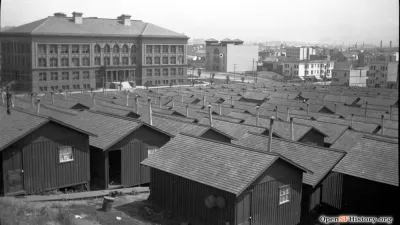As disaster relief efforts began to grow in the Philippine city of Tacloban and surrounding areas in the aftermath of Typhoon Haiyan, logistical difficulties are hampering aid efforts. 90 percent of the city is thought to have been destroyed.
"The BBC's Jonathan Head in Tacloban, a devastated city of 220,000 on Leyte island, says Wednesday brought the first signs of an organised response [to Typhoon Haiyan]," reports the BBC. "US military planes have been arriving at Tacloban's ruined airport, delivering World Food Programme supplies, which can be carried by helicopter to outlying regions, and a French-Belgian field hospital has been set up."
However, writing in The New York Times, Keith Bradsher notes that, "Typhoon relief gridlock threatened to paralyze rescue operations in the most devastated part of the Philippines on Wednesday, with aid piling up but few ways to distribute it, plentiful gasoline but no merchants willing to sell it, and an influx of emergency volunteers with no places to house them."
Though relief may be on the way, desperation is beginning to spread in the devastated city, five days after the storm struck. "Many people have left Tacloban, says our correspondent, but among those left behind there is a growing sense of panic and fear, not just of food running out but of law and order breaking down," adds the BBC.
FULL STORY: Typhoon Haiyan: Philippines defends aid response

Planetizen Federal Action Tracker
A weekly monitor of how Trump’s orders and actions are impacting planners and planning in America.

Restaurant Patios Were a Pandemic Win — Why Were They so Hard to Keep?
Social distancing requirements and changes in travel patterns prompted cities to pilot new uses for street and sidewalk space. Then it got complicated.

Map: Where Senate Republicans Want to Sell Your Public Lands
For public land advocates, the Senate Republicans’ proposal to sell millions of acres of public land in the West is “the biggest fight of their careers.”

Maui's Vacation Rental Debate Turns Ugly
Verbal attacks, misinformation campaigns and fistfights plague a high-stakes debate to convert thousands of vacation rentals into long-term housing.

San Francisco Suspends Traffic Calming Amidst Record Deaths
Citing “a challenging fiscal landscape,” the city will cease the program on the heels of 42 traffic deaths, including 24 pedestrians.

California Homeless Arrests, Citations Spike After Ruling
An investigation reveals that anti-homeless actions increased up to 500% after Grants Pass v. Johnson — even in cities claiming no policy change.
Urban Design for Planners 1: Software Tools
This six-course series explores essential urban design concepts using open source software and equips planners with the tools they need to participate fully in the urban design process.
Planning for Universal Design
Learn the tools for implementing Universal Design in planning regulations.
Heyer Gruel & Associates PA
JM Goldson LLC
Custer County Colorado
City of Camden Redevelopment Agency
City of Astoria
Transportation Research & Education Center (TREC) at Portland State University
Camden Redevelopment Agency
City of Claremont
Municipality of Princeton (NJ)



























